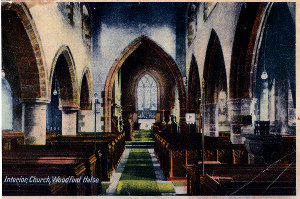Woodford Buildings
St Mary’s
Not many people stop to think how churches and the like, were heated and lighted in days gone by. Candles would be the only means of lighting for hundreds of years, right up to the 19th century, when paraffin lamps came into use. When the church first made use of the new means of lighting is not known, but it is known that the Methodists in the village ceased to buy candles in 1869 and it is assumed that they changed to paraffin lamps and no doubt, the church would change at about the same time, or perhaps earlier. It is known that paraffin lamps were used, because it is recorded in the Parish Magazine that they were sold when gas lamps took their place.
Gas came to the village in 1909 and the church very soon made use of it as the Parish Magazine for October, 1912, records that gas was used for the first time on Sunday, 4th. September, and it was declared to be an “unqualified success”. Eight lamps had been installed in the nave and six in the chancel, the cost was given as £15 and £11 had already been collected towards this. Electricity came to the village in 1929, but when the church first made use of it is not known.
The heating of places of assembly must always have posed problems, for churches in particular, with their high ceilings and usually, a tower. It is probable that there was no means of heating at all, until coke stoves became available in the 19th. century. The churchwardens accounts for 1810 show an expenditure on coke and wood and in 1866 money was spent on the repair of a stove, and coke was being bought from Daventry. What sort of stove was being used is not known and again, although it is known that a form of heating was installed when the church was renovated in 1878, what method was used is not disclosed in the Vicar’s report on the work done.
How long that system of heating lasted, whatever it was, is not known, but in February, 1935, it was proposed at a P.C.C. meeting, “That an efficient system of heating be installed before next winter”. In the following May, tenders for heating were considered and then, in June, a pipe-less means of heating was brought to their notice which would cost £136 plus builder’s costs, estimated at £45 and it was decided that the Macleary Pipe-less System be accepted. The final bill evidently came to £184-9-7d, as in April, 1936, it was said that £90 had been collected and there was £94-9-7d outstanding.
But 1946 enquiries were being made as to the possibility of heating the church by electricity, but it was found that the load to the church could not be increased, presumably the conductors would not carry an increased load, so there could be no heating of the church by electricity. It seems that the difficulty must have been overcome, as by 1977 the coke fired boiler had been replaced by an electric system, on a restricted hours tariff.
